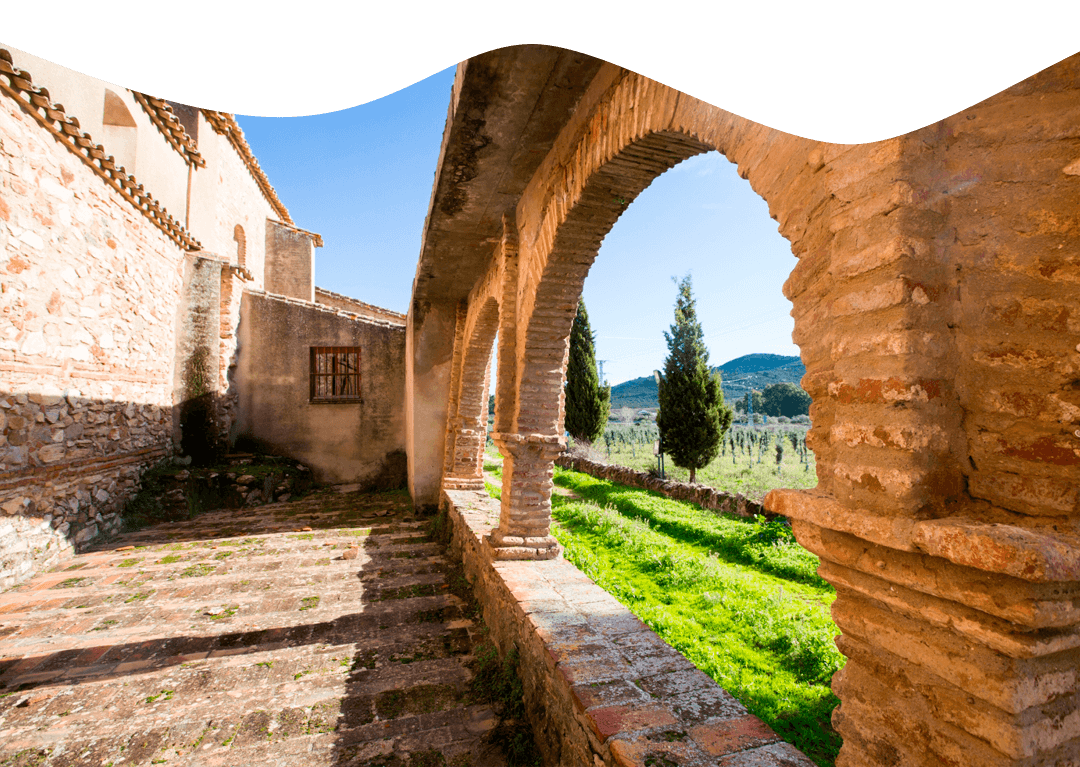

En esta ruta emprenderemos un viaje por el tiempo a través de la Historia de Archena y de las culturas que la cimentaron.
Te mostramos lo mejor de la ruta
Iniciarás tu primera parada en los Jardines del Museo de Archena, frente a él, se impone un cerro llamado “Cabezo del Tío Pío”, aquí se encuentra uno de los asentamientos iberos más importantes del territorio nacional, ya que la cerámica que se ha encontrado tiene una característica común con la encontrada en Elche, a su estilo se le denomina “Elche-Archena”, pero lo que hace a este asentamiento verdaderamente importante es el llamado “Vaso de los Guerreros” una pieza única, que actualmente se encuentra en el museo arqueológico nacional, lugar que también debes visitar en Archena.
Avanzando por el paseo Vicente Medina, disfrutando de su poesía y el espacio natural, que tienes ante tus ojos llegarás a la Presa de los Mazos.
Las acequias de Archena contaban en su discurrir por el término municipal con numerosas norias y otros artilugios para la elevación de agua, que en el siglo XVIII poblaban la huerta.
Esta presa desvía el agua hacia un canal que discurre paralelo al río por la margen izquierda y lleva el agua a la central eléctrica situada junto al Puente de Hierro. De ahí parte también la acequia de La Caravija que riega las huertas de La Algaida y tiene su cola en la acequia Mayor de Molina en el paraje de La Torre del Junco.
Los riegos de Archena están abastecidos exclusivamente por el Río Segura a través de las sus cuatro acequias, que son las arterias por donde circula el agua que va a permitir que la vida llegue a donde el río por sí mismo no puede.
Seguimos hasta el principio del Paseo de Vicente Medina.
La montaña que se ve enfrente a la izquierda fue de gran importancia en el transcurso de la época medieval, ya que en ella se asentó un castillo de época islámica que controlaba la entrada al Valle de Ricote y los castillos de Blanca y Ulea.
Avanzando por la derecha por el Paseo del Balneario, llegaremos al popular Balneario de Archena, lugar de especial interés, ya que aquí se encuentran los más valorados vestigios arqueológicos de las distintas civilizaciones que durante miles de años poblaron las tierras archeneras. En la entrada del balneario se encuentra esta copia detallada de la Fuente de los Leones de la Alhambra.
Luego finalmente te encontrarás con las ruinas de un “masío” romano, lugar regentado por el Imperio y que servía de posada y hospedaje para altos cargos y personalidades de alto rango.
 Escucha las audioguías de la ruta
Escucha las audioguías de la rutaHaz clic en el play en cada parada
Parada 1: Jardín del Museo de Archena
El Jardín del Museo de Archena es un espacio verde situado en el centro de la ciudad, junto al Museo de Archena. Es un oasis de tranquilidad y belleza en el corazón de la ciudad, donde se pueden contemplar diferentes especies de plantas y árboles autóctonos de la zona.
Parada 2: Presa de los Mazo
La Presa de Los Mazos es una presa situada en la zona de Archena. Se encuentra en el curso del río Segura y es una de las principales fuentes de suministro de agua de la región. Se encuentra en un entorno natural privilegiado, rodeada de montañas y vegetación autóctona, lo que la convierte en un lugar ideal para disfrutar de la naturaleza.
Parada 3: Entrada del Paseo de Vicente Medina
Llamado así en honor al ilustre poeta y dramaturgo Vicente Medina, el Paseo de Vicente Medina es un lugar emblemático de la ciudad que combina a la perfección la belleza natural con la riqueza cultural e histórica.
Parada 4: Balneario de Archena
El Balneario de Archena es uno de los complejos termales más prestigiosos y reconocidos de España. El balneario se encuentra en una zona privilegiada, rodeado de un entorno natural de gran belleza, en el que se combinan las montañas y el río Segura.
Parada 5: Yacimiento Romano
El Yacimiento Romano de Archena es un importante conjunto arqueológico que se encuentra en nuestro municipio. Este yacimiento arqueológico es un testimonio de la presencia romana en la zona, que data de los siglos III y IV después de Cristo.
We firmly believe that the internet should be available and accessible to anyone, and are committed to providing a website that is accessible to the widest possible audience, regardless of circumstance and ability.
To fulfill this, we aim to adhere as strictly as possible to the World Wide Web Consortium’s (W3C) Web Content Accessibility Guidelines 2.1 (WCAG 2.1) at the AA level. These guidelines explain how to make web content accessible to people with a wide array of disabilities. Complying with those guidelines helps us ensure that the website is accessible to all people: blind people, people with motor impairments, visual impairment, cognitive disabilities, and more.
This website utilizes various technologies that are meant to make it as accessible as possible at all times. We utilize an accessibility interface that allows persons with specific disabilities to adjust the website’s UI (user interface) and design it to their personal needs.
Additionally, the website utilizes an AI-based application that runs in the background and optimizes its accessibility level constantly. This application remediates the website’s HTML, adapts Its functionality and behavior for screen-readers used by the blind users, and for keyboard functions used by individuals with motor impairments.
If you’ve found a malfunction or have ideas for improvement, we’ll be happy to hear from you. You can reach out to the website’s operators by using the following email
Our website implements the ARIA attributes (Accessible Rich Internet Applications) technique, alongside various different behavioral changes, to ensure blind users visiting with screen-readers are able to read, comprehend, and enjoy the website’s functions. As soon as a user with a screen-reader enters your site, they immediately receive a prompt to enter the Screen-Reader Profile so they can browse and operate your site effectively. Here’s how our website covers some of the most important screen-reader requirements, alongside console screenshots of code examples:
Screen-reader optimization: we run a background process that learns the website’s components from top to bottom, to ensure ongoing compliance even when updating the website. In this process, we provide screen-readers with meaningful data using the ARIA set of attributes. For example, we provide accurate form labels; descriptions for actionable icons (social media icons, search icons, cart icons, etc.); validation guidance for form inputs; element roles such as buttons, menus, modal dialogues (popups), and others. Additionally, the background process scans all of the website’s images and provides an accurate and meaningful image-object-recognition-based description as an ALT (alternate text) tag for images that are not described. It will also extract texts that are embedded within the image, using an OCR (optical character recognition) technology. To turn on screen-reader adjustments at any time, users need only to press the Alt+1 keyboard combination. Screen-reader users also get automatic announcements to turn the Screen-reader mode on as soon as they enter the website.
These adjustments are compatible with all popular screen readers, including JAWS and NVDA.
Keyboard navigation optimization: The background process also adjusts the website’s HTML, and adds various behaviors using JavaScript code to make the website operable by the keyboard. This includes the ability to navigate the website using the Tab and Shift+Tab keys, operate dropdowns with the arrow keys, close them with Esc, trigger buttons and links using the Enter key, navigate between radio and checkbox elements using the arrow keys, and fill them in with the Spacebar or Enter key.Additionally, keyboard users will find quick-navigation and content-skip menus, available at any time by clicking Alt+1, or as the first elements of the site while navigating with the keyboard. The background process also handles triggered popups by moving the keyboard focus towards them as soon as they appear, and not allow the focus drift outside of it.
Users can also use shortcuts such as “M” (menus), “H” (headings), “F” (forms), “B” (buttons), and “G” (graphics) to jump to specific elements.
We aim to support the widest array of browsers and assistive technologies as possible, so our users can choose the best fitting tools for them, with as few limitations as possible. Therefore, we have worked very hard to be able to support all major systems that comprise over 95% of the user market share including Google Chrome, Mozilla Firefox, Apple Safari, Opera and Microsoft Edge, JAWS and NVDA (screen readers), both for Windows and for MAC users.
Despite our very best efforts to allow anybody to adjust the website to their needs, there may still be pages or sections that are not fully accessible, are in the process of becoming accessible, or are lacking an adequate technological solution to make them accessible. Still, we are continually improving our accessibility, adding, updating and improving its options and features, and developing and adopting new technologies. All this is meant to reach the optimal level of accessibility, following technological advancements. For any assistance, please reach out to
